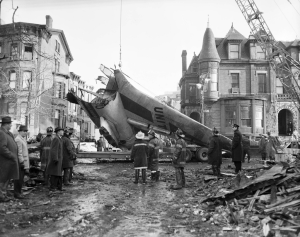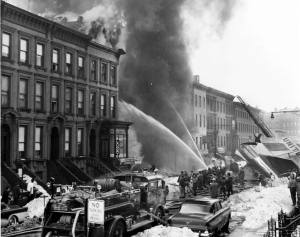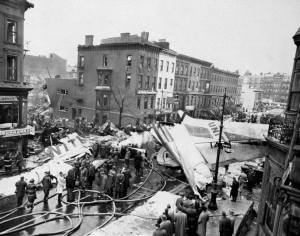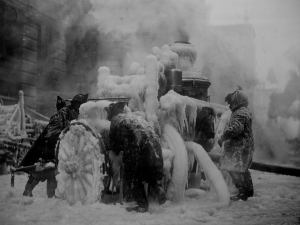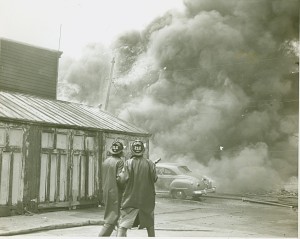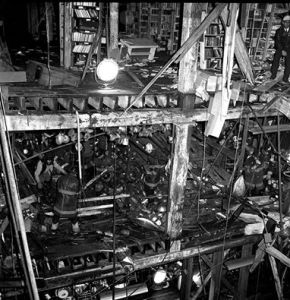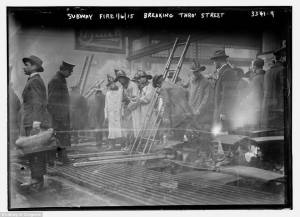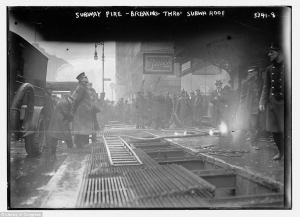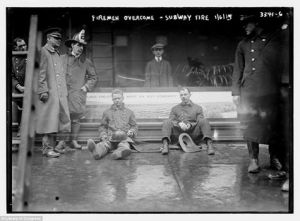December 16, 1960-
At 10:34, on a foggy morning, two planes collided over NYC. One plane crashed at Miller Field in Staten Island. The second plane, struggled to stay aloft only to crash into one of the most densely populated neighborhoods in the city: Park Slope in Brooklyn. A wing clipped an apartment house as the plane drove into the street and a row of buildings at Sterling Place and Seventh Avenue. An elderly man startled by the crash, pulled the fire alarm box sending Engines 269, 280 & 219 along with Ladders 105 & 132 to Box 1231. The first due units arrived quickly to find 11 buildings in flames. Within minutes Battalion 48 had transmitted a 2nd & 3rd alarms. Lt. Bush of L-105 split his men and tried to cover the flaming fuselage of the plane and a blazing apartment building. As the officer and his team crawled into the burning building, Firemen Rogan & Dailey entered the blazing plane armed with only extinguishers. As Dailey held back the flames, Rogan cut two people from their seats and pulled them from the blazing wreckage. Amazingly the passengers were still alive.
Inside the apartment, heavy fire was filling the first and fifth floors as jet fuel fed flames burned up the outside and in through broken windows and gaps in the damaged structure. Fireman Browne found an elderly woman and together with Lt. Bush carried her to safety. They then found and removed an injured man just as the flaming building collapsed. Within ten minutes of the initial alarm, a 2nd, 3rd, and 4th alarms and special calls for Rescue 1 & 4 had been transmitted. The plane’s fuselage crashed into the Pillar of Fire Church which was completely destroyed by the resulting fire and explosions. Engine companies stretched lines and began battling the row of buildings set ablaze by flaming jet fuel.
The neighborhood was now in a complete panic. Mothers and their children fled from their homes onto the snowy streets. Others opened their doors to a wall of flames and had to escape through the rear. Rumors a school with 1500 students inside had been hit, only increased the drama. (Luckily the school was okay).
Despite the intense heat, and tottering walls, Rescue, Squad and Laddermen moved into the blazing areas covered by attack lines. Team after team advanced across the shattered debris and into the raging fires. In all 38 lines were stretched and operated. Thirty one engines, six ladder companies, three rescue companies, and four special units operated at this fire.
When the smoke finally cleared, the toll was devastating: 84 passengers on the Brooklyn plane were killed. Six people on the ground were killed, fifteen civilians and seventeen firemen were injured. In Staten Island all 44 people on the plane had been killed.
In Brooklyn, 200 off-duty firemen responded and worked at the scene. The firefighting and recovery efforts at this, the worst commercial airline crash (at that time), would go on for several days. For the next several days members of the FDNY combed the wreckage of the crashed airliner, and searched the shattered neighborhood buildings. Pockets of fire were extinguished as the devastation left behind became evident. The six people killed on the ground were: an elderly church caretaker, a sanitation worker shoveling snow, two men selling Christmas trees on the sidewalk, a butcher in his shop and a man walking his dog.
A total of 134 people had lost their lives.
For their heroic rescues upon arrival, Lt. Bush, Firemen Browne, Dailey and Rogan of Ladder 105 were later awarded medals. John Rogan was also treated at the hospital for second degree burns.
Paul Hashagen
